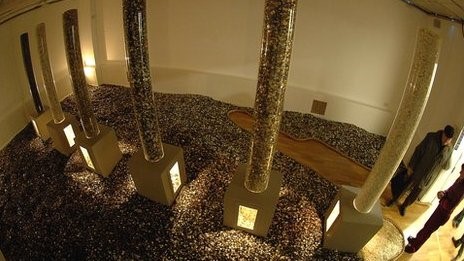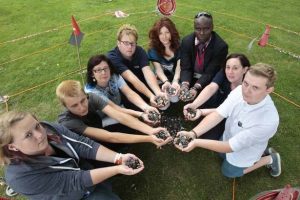
‘6 million +’ – the Button Memorial
The 6 million + installation, which contains over six million buttons, has caught the imagination of thousands of people, inspiring a Yorkshire local authority to build the region’s first permanent Holocaust memorial.
The memorial’s purpose is to ‘ignite and flame confidence, hope and passion, encouraging people to stand up as individuals and in groups to make a positive difference to the lives of others.
You can download a PDF version of the 6 million + life story here
6 million + Welsh language life story

On 25 January 2006, Huddersfield Art Gallery launched an installation called 6 million + to commemorate the victims of the Holocaust. It was created by local Kirklees artist Antonia Stowe, with the support of Kirklees Museum and Galleries and Huddersfield Art Gallery. Her aim was to encourage people to address and reflect upon the horrors of the Holocaust and subsequent genocides, whilst also promoting the positive message that every person can make a difference.
The installation is made up of over six million individual buttons, donated by the local community. The buttons are arranged into towers which stand tall over the viewer, especially children, enabling them to reflect both on the scale of the Holocaust and the vast number of lives affected by it.
Since 2006, 6 million + has been a huge success and has had an impact on thousands of people. It has toured the UK, inspired a sister project in New Zealand, and has become Yorkshire’s first public Holocaust memorial sculpture. After its launch, support for 6 million + grew quickly. While initially its buttons were donated by people in the Kirklees community, as the installation attracted wider attention donations came from across the UK. It even received donations from as far as the United States of America. It remained in Kirklees Art Gallery until January 2007 when it began a four-year tour of the United Kingdom. Over this period it visited several communities, including Newcastle-upon-Tyne’s Guildhall, Brent Cross Shopping Centre in London, Dewsbury Museum and Ripon Cathedral. This tour saw its profile rise even further, as it gained significant media attention and inspired a growing audience with its positive message.
6 million + returned to Huddersfield Art Gallery in February 2011 where it continued to both move and inspire people. It remained at the gallery for three years until Kirklees Council launched a commemorative programme to ensure its positive impact would continue.
On Holocaust Memorial Day 2014, Kirklees Council announced plans to build Yorkshire’s first public Holocaust memorial, based on 6 million +. The council also announced the creation of an independent trust to manage the memorial and run projects engaging with the local community. The trust would aim to raise approximately £1.5 million to install the sculpture and deliver a programme of activities commemorating the Holocaust, including public workshops and talks from survivors. Like 6 million +, the purpose of this programme is to encourage people to address and reflect upon the horrors of the Holocaust and subsequent genocides, whilst also promoting the positive theme that every person can make a difference. The programme included workshops encouraging participants to consider ways of tackling modern issues that threaten to divide communities, such as racism.
When Antonia Stowe created 6 million +, she said its purpose was to ‘ignite and flame confidence, hope and passion, encouraging people to stand up as individuals and in groups to make a positive difference to the lives of others’. Having reached thousands of people across the UK with its message already, 6 million + will now continue to act as a source of inspiration as a permanent Holocaust memorial in Kirklees.

For more information:
- Read about the Holocaust on the HMDT website
- The official 6 million + website
- Antonia Stowe’s official website
- ‘Holocaust memorial statue location to be announced’, ITV News, 30 January 2014
- ‘D-day for Kirklees Holocaust tribute sculpture’, Huddersfield Daily Examiner, 20 January 2014